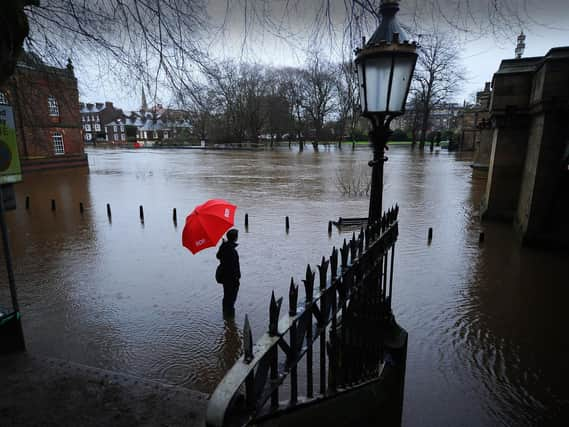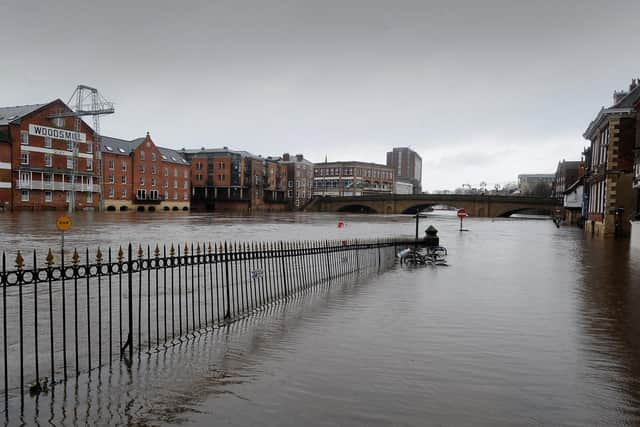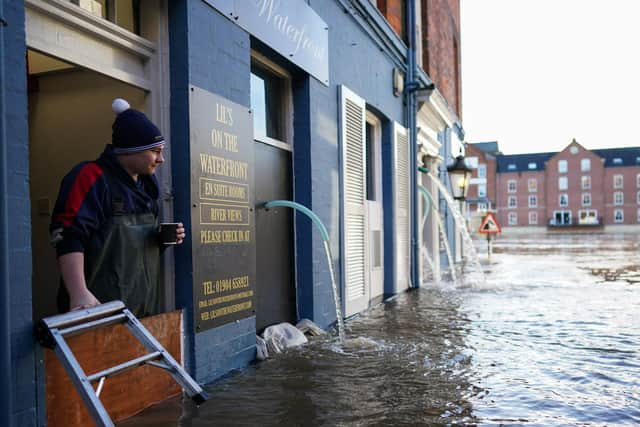Climate change poses 'critical risk' to riverside heritage in York, business leaders' report warns


The Celebrating Our Distinctive Heritage report, which has been commissioned by the York and North Yorkshire Local Enterprise Partnership and Historic England, warns the effects of climate change are already being felt in Britain and are set to have a considerable impact on life in the region.
“The effects of climate change are already being felt, even in Britain, through the emerging pattern of warmer, wetter winters, hotter, drier summers and increased storminess and frequency of severe weather events,” the report, which is being formally published tomorrow, states.
Advertisement
Hide AdAdvertisement
Hide Ad“The heritage assets of our market towns are comparatively resilient to the effects of climate change, but those in riparian locations are often vulnerable to flooding.”


In the section looking at how historic buildings and heritage assets in York can be better utilised, it warns that climate change carries considerable risk for the city.
“The effects of climate change are a particular concern – contributing to more frequent, and more intense, severe weather events,” it states.
“This poses a critical risk to riverside heritage assets, both in terms of direct impacts from floodwaters and debris, and also the potential need to enhance flood defences in future.”
Advertisement
Hide AdAdvertisement
Hide AdThe report adds: “Adaptation to climate change is a critical step for York. In addition to the upstream management of stormwater, ensuring historic buildings are well maintained and, where necessary, rainwater goods and drainage systems are sensitively upgraded to assist in ‘future-proofing’ will be


important.
“Similarly, as the historic core has relatively few green spaces, ensuring these areas – and any opportunities for new public realm in parallel with new development – maximise opportunities for retention and storage of stormwater will be valuable in helping reduce pressure on the drainage network and the city’s watercourses.
“In a city as archaeologically sensitive as York, there are naturally limits to the types of solutions that might be appropriate – but significant benefits could be realised through application of permeable surface treatments to existing streetscape and parking.”
The report notes similar concerns about coastal locations.
“Systems of pillboxes and anti-tank defences line the Holderness coast, although erosion, exacerbated by sea level rise and increased storminess as a consequence of climate change, threaten much of the surviving network.
Advertisement
Hide AdAdvertisement
Hide Ad“Climate change and the action of the sea is a persistent theme in the area. The soft, easily eroded shoreline of the Holderness Coast is a key part of its geological interest and landscape character – facilitating the high-energy coastal processes that create the characteristic beaches and dynamic
sandbars and tidal islands of Spurn Head.
“Exposed to time and tide, the area’s coastline, especially that from Flamborough to Spurn Head, is some of the most dynamic and vulnerable to erosion in the country. The effects of climate change – in the form of sea level rise and increased frequency and intensity of storm events – are likely to take
their toll on coastal heritage and communities alike.
“It is a sad fact that much of the region’s heritage at risk from the effects of climate change and coastal erosion cannot be saved from the sea. It can, however, be recorded, understood and celebrated before the inevitable occurs. There is, however a need to engage local people with the scale of the threat, and ensure that stakeholders are actively planning to manage risks and capitalise on interest.”
Work 'should take place with Environment Agency'
The report recommends that local leaders work with the Environment Agency and other key partners “to understand the need for, and impacts of likely scenarios for climate change and the necessary flood management responses – to enable positive planning for the historic environment”.
Advertisement
Hide AdAdvertisement
Hide AdIt adds that as part of the Local Enterprise Partnership’s wider climate change agenda, work should take place with partners “to promote the sustainability and carbon management benefits of retaining and adapting heritage assets, from buildings to landscapes”.
Support The Yorkshire Post and become a subscriber today. Your subscription will help us to continue to bring quality news to the people of Yorkshire. In return, you'll see fewer ads on site, get free access to our app and receive exclusive members-only offers. Click here to subscribe.